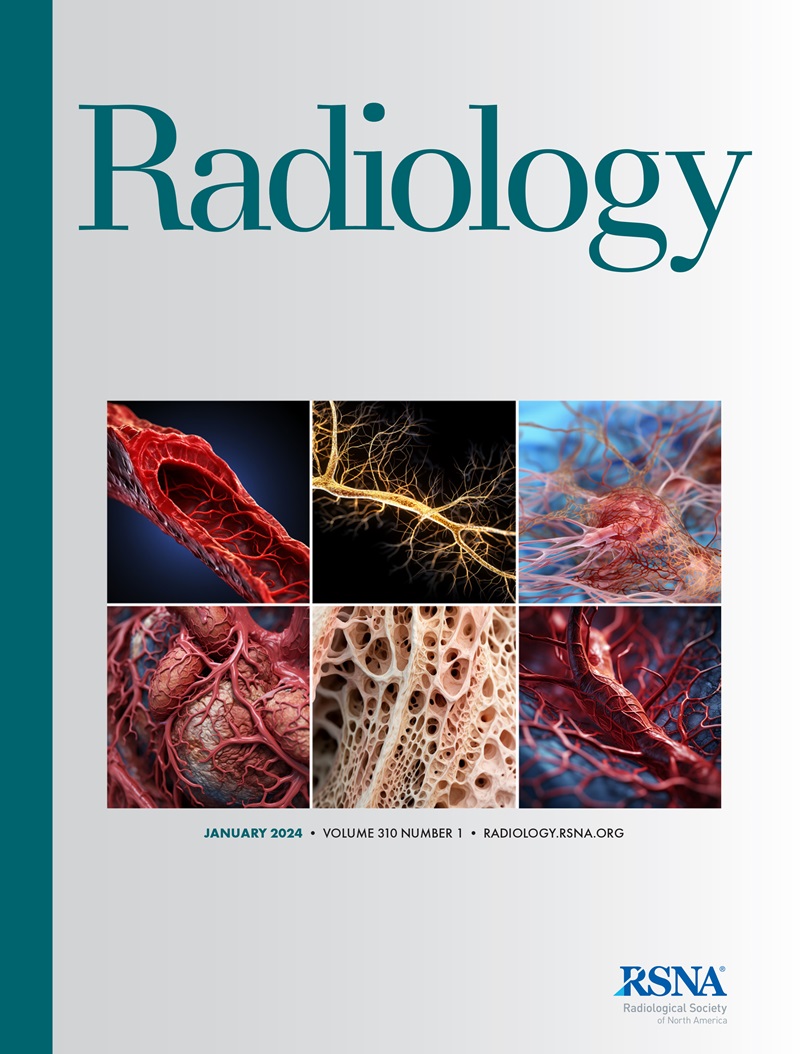Yuhong Huang, Xinyang Song, Yilin Chen, Han Qiu, Tianhan Zhou, Siqi Wang, Yang Zhou, Wei Li, Ying Lin, Qian Wang, Wenchao Gu, Teng Zhu, Kun Wang
求助PDF
{"title":"预测乳腺癌新辅助治疗后肿瘤缩小模式的肿瘤内微生物相关MRI模型。","authors":"Yuhong Huang, Xinyang Song, Yilin Chen, Han Qiu, Tianhan Zhou, Siqi Wang, Yang Zhou, Wei Li, Ying Lin, Qian Wang, Wenchao Gu, Teng Zhu, Kun Wang","doi":"10.1148/radiol.243545","DOIUrl":null,"url":null,"abstract":"<p><p>Background Patients with breast cancer exhibit different tumor shrinkage patterns (TSPs) after neoadjuvant therapy (NAT), making accurate TSP prediction essential for breast-conserving surgery planning. The intratumoral microbiome influences treatment response, and related imaging features may improve TSP prediction. Purpose To develop an intratumoral microbiome-related MRI model that accurately predicts TSP following NAT. Materials and Methods This retrospective study included patients with breast cancer who underwent NAT followed by surgery at 12 institutions between July 2015 and April 2023. Patients were allocated to training (<i>n</i> = 671), internal validation (<i>n</i> = 335), and external validation (<i>n</i> = 1243) sets. Pre-NAT and mid-NAT MRI scans were collected for model development and validation. Five models integrating three-dimensional U-Net automated segmentation, habitat radiomic and/or deep learning (ResNet-50) features, and histologic intratumoral microbiome data were developed: pre-NAT habitat, mid-NAT habitat, pre-NAT ResNet-50, mid-NAT ResNet-50, and a fusion model. Models were validated across molecular subtypes and tumor stages using receiver operating characteristic curves, confusion matrices, and diagnostic metrics. Shapley additive explanations were used to interpret model output. Results Among 2249 women with breast cancer (median age, 49 years [IQR, 42-56 years]), 1238 (55%) experienced concentric shrinkage. Tumors with concentric shrinkage had increased microbiome abundance (<i>P</i> < .001). The three-dimensional U-Net achieved Dice coefficients of 0.96, 0.92, and 0.91 on pre-NAT MRI scans and 0.96, 0.90, and 0.88 on mid-NAT MRI scans in the training, internal validation, and external validation sets, respectively. The fusion model outperformed single-time point models in the internal validation set (area under the receiver operating characteristic curve [AUC], 0.89 vs 0.80-0.83; all <i>P</i> < .05) and external validation set (AUC, 0.87 vs 0.74-0.81; all <i>P</i> < .001), remaining robust across molecular subtypes (AUC range, 0.85-0.91) and tumor stages (AUC range, 0.84-0.89). Shapley additive explanations confirmed that each imaging feature independently predicted TSP. Conclusion An intratumoral microbiome-related MRI model enabled precise TSP prediction. © The Author(s) 2025. Published by the Radiological Society of North America under a CC BY 4.0 license. <i>Supplemental material is available for this article.</i></p>","PeriodicalId":20896,"journal":{"name":"Radiology","volume":"316 2","pages":"e243545"},"PeriodicalIF":15.2000,"publicationDate":"2025-08-01","publicationTypes":"Journal Article","fieldsOfStudy":null,"isOpenAccess":false,"openAccessPdf":"","citationCount":"0","resultStr":"{\"title\":\"Intratumoral Microbiome-related MRI Model for Predicting Breast Cancer Shrinkage Pattern Following Neoadjuvant Therapy.\",\"authors\":\"Yuhong Huang, Xinyang Song, Yilin Chen, Han Qiu, Tianhan Zhou, Siqi Wang, Yang Zhou, Wei Li, Ying Lin, Qian Wang, Wenchao Gu, Teng Zhu, Kun Wang\",\"doi\":\"10.1148/radiol.243545\",\"DOIUrl\":null,\"url\":null,\"abstract\":\"<p><p>Background Patients with breast cancer exhibit different tumor shrinkage patterns (TSPs) after neoadjuvant therapy (NAT), making accurate TSP prediction essential for breast-conserving surgery planning. The intratumoral microbiome influences treatment response, and related imaging features may improve TSP prediction. Purpose To develop an intratumoral microbiome-related MRI model that accurately predicts TSP following NAT. Materials and Methods This retrospective study included patients with breast cancer who underwent NAT followed by surgery at 12 institutions between July 2015 and April 2023. Patients were allocated to training (<i>n</i> = 671), internal validation (<i>n</i> = 335), and external validation (<i>n</i> = 1243) sets. Pre-NAT and mid-NAT MRI scans were collected for model development and validation. Five models integrating three-dimensional U-Net automated segmentation, habitat radiomic and/or deep learning (ResNet-50) features, and histologic intratumoral microbiome data were developed: pre-NAT habitat, mid-NAT habitat, pre-NAT ResNet-50, mid-NAT ResNet-50, and a fusion model. Models were validated across molecular subtypes and tumor stages using receiver operating characteristic curves, confusion matrices, and diagnostic metrics. Shapley additive explanations were used to interpret model output. Results Among 2249 women with breast cancer (median age, 49 years [IQR, 42-56 years]), 1238 (55%) experienced concentric shrinkage. Tumors with concentric shrinkage had increased microbiome abundance (<i>P</i> < .001). The three-dimensional U-Net achieved Dice coefficients of 0.96, 0.92, and 0.91 on pre-NAT MRI scans and 0.96, 0.90, and 0.88 on mid-NAT MRI scans in the training, internal validation, and external validation sets, respectively. The fusion model outperformed single-time point models in the internal validation set (area under the receiver operating characteristic curve [AUC], 0.89 vs 0.80-0.83; all <i>P</i> < .05) and external validation set (AUC, 0.87 vs 0.74-0.81; all <i>P</i> < .001), remaining robust across molecular subtypes (AUC range, 0.85-0.91) and tumor stages (AUC range, 0.84-0.89). Shapley additive explanations confirmed that each imaging feature independently predicted TSP. Conclusion An intratumoral microbiome-related MRI model enabled precise TSP prediction. © The Author(s) 2025. Published by the Radiological Society of North America under a CC BY 4.0 license. <i>Supplemental material is available for this article.</i></p>\",\"PeriodicalId\":20896,\"journal\":{\"name\":\"Radiology\",\"volume\":\"316 2\",\"pages\":\"e243545\"},\"PeriodicalIF\":15.2000,\"publicationDate\":\"2025-08-01\",\"publicationTypes\":\"Journal Article\",\"fieldsOfStudy\":null,\"isOpenAccess\":false,\"openAccessPdf\":\"\",\"citationCount\":\"0\",\"resultStr\":null,\"platform\":\"Semanticscholar\",\"paperid\":null,\"PeriodicalName\":\"Radiology\",\"FirstCategoryId\":\"3\",\"ListUrlMain\":\"https://doi.org/10.1148/radiol.243545\",\"RegionNum\":1,\"RegionCategory\":\"医学\",\"ArticlePicture\":[],\"TitleCN\":null,\"AbstractTextCN\":null,\"PMCID\":null,\"EPubDate\":\"\",\"PubModel\":\"\",\"JCR\":\"Q1\",\"JCRName\":\"RADIOLOGY, NUCLEAR MEDICINE & MEDICAL IMAGING\",\"Score\":null,\"Total\":0}","platform":"Semanticscholar","paperid":null,"PeriodicalName":"Radiology","FirstCategoryId":"3","ListUrlMain":"https://doi.org/10.1148/radiol.243545","RegionNum":1,"RegionCategory":"医学","ArticlePicture":[],"TitleCN":null,"AbstractTextCN":null,"PMCID":null,"EPubDate":"","PubModel":"","JCR":"Q1","JCRName":"RADIOLOGY, NUCLEAR MEDICINE & MEDICAL IMAGING","Score":null,"Total":0}
引用次数: 0
引用
批量引用

 求助内容:
求助内容: 应助结果提醒方式:
应助结果提醒方式:


